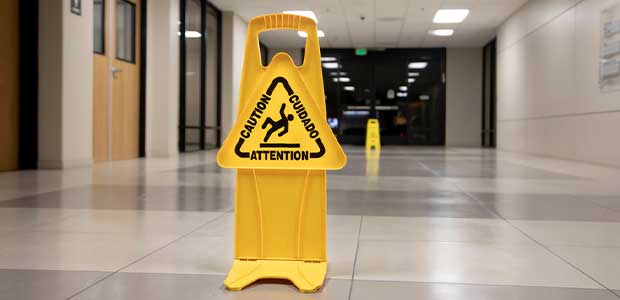
Simple Ways to Avoid Slips and Falls at the Office
Minimizing employee risk of slips and falls can be easier than you think.
- By Rupert Jones
- Jan 23, 2023
Most slips and falls in workplaces are avoidable, so long as you’ve got the right policies, best practices and features in place on-site.
What is more, reducing their prevalence doesn’t have to be difficult; here are a few straightforward strategies that will work a treat.
Keep Your Work Area Clean and Clear of Clutter
Clutter can be a major cause of slips and falls in the workplace. Business owners and managers need to create an orderly environment for their employees by removing excess items, such as boxes, cords, and wires.
Also make sure desks are kept neat and tidy so that everything is visible, and place non-slip mats under heavy furniture or equipment to prevent them from sliding on slick surfaces.
In addition, be sure to deal with any liquid spills immediately using absorbent materials like paper towels or sawdust. Quick action is the way to avert common office injuries.
Educate Employees on the Dangers of Slips and Falls
A proactive approach to stopping slips and falls requires that you educate your employees on how to do their bit.
Make sure they understand what their responsibilities are, and how to adhere to safety policies that you’ve put in place. For instance, remind them not to wear shoes with slick soles in the office.
Team members must additionally be capable of coping with the aftermath of a workplace accident; first aid training, including the ability to check for post concussion syndrome, will make a big difference in terms of the outcomes of injuries that do occur.
Providing formal training in office health and safety, both for new hires and existing employees, will deliver the best results in this case. It’s also important to set out what each team member is expected to do, both to protect themselves and to help their colleagues.
Implement a Slip-Resistant Flooring Policy
Business owners should invest in slip-resistant flooring, for obvious reasons. Choose non-slip materials for high traffic areas, such as hallways and bathrooms, which are more likely to get wet or slippery.
Also consider installing mats with raised edges at entrances to catch dirt and moisture from shoes. Keeping surfaces dry is another way to prevent slips; so be sure to provide mops and buckets for employees who may need them.
Install Handrails in High Traffic Areas for Stability
Handrails are a great way to increase safety in the office. They provide stability and help prevent slips and falls, especially in areas with high foot traffic such as stairwells or hallways.
Consider installing handrails at regular intervals along paths of travel both indoors and out to ensure the safety of employees and other visitors to the site.
Also check that handrails are securely attached to walls or posts so that they do not become loose over time due to frequent use. Regular maintenance and repairs will give you extra peace of mind, and limit the likelihood of injuries befalling anyone who uses the office space.
Regularly Inspect Office Spaces for Potential Hazards
Perhaps the most vital piece of advice is to not rest on your laurels, but instead be vigilant to any issues which might be a danger to employees and to yourself during office hours.
This means you or a team member must regularly inspect the workplace for potential hazards that may lead to slips and falls.
Look for loose flooring, broken handrails, or any other objects that could cause an accident, including liquid spills and loose cables. In particular, be sure to check areas with high foot traffic such as stairwells, hallways or spaces between desks or cubicles.
Doing these simple checks will help you identify any potential risks before they become a problem, rather than letting them remain in place for longer, amplifying the chances of disaster striking and a liability claim being made against you.
Final Thoughts
Every hazard you remove is one less accident waiting to happen in the office, so start taking slips and falls seriously if you want to tackle them successfully.
As you can see, it doesn’t have to be a difficult process, and in fact will make your office a happier, safer place to work overall.
Photo credit: F Armstrong Photography / Shutterstock.com